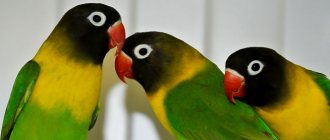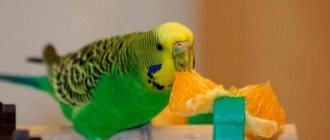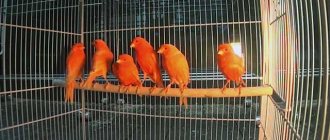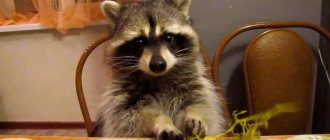Corella
Corella is a close relative of the cockatoo. In nature, this species is found in Australia and is prohibited from being caught and exported, but it is kept in captivity and bred by hobbyists all over the world. Among all the medium-sized parrots, the cockatiel is the most widespread species in captivity. This is due to the ease of its maintenance and breeding, as well as its affordable price.
The size of the cockatiel reaches 30-33 cm, body weight - 90-100 g. There is a long crest on the head. Natural color is gray with white areas on the wings. The head and crest are yellow, with large orange spots on the cheeks. Females are paler in color than males. During the selection process, other color options were obtained: white, light yellow, brown, spotted.
Ruffled parrot
The Ruffed Parakeet is a medium-sized parrot kept in captivity by bird lovers around the world. The natural range is limited to a number of areas in Africa and South Asia, but due to its ability to adapt to cold climates, the species has formed secondary wild populations in some regions of Europe and the USA.
The body length of the necklace parrot reaches 40-42 cm, weight - 115-140 g. Natural color is bright green; the wings, tail and back have a bluish tint. Breeders have bred blue, yellow, white and variegated morphs. The beak is large, bright red. A narrow black stripe shaped like a “necklace” runs from the bottom of the beak around the neck. Females do not have this stripe.
In nature, necklace parrots live in colonies of several dozen individuals. In captivity they are kept singly or in pairs. Birds are well tamed and remember human speech.
Which parrot to choose?
Before choosing a parrot, you need to determine for yourself the desired criteria for your future feathered friend:
- Breed. Her choice depends on the experience in keeping birds. If this is your first pet, it is better to choose wavy birds, lovebirds, and cockatiels. They have a cheerful disposition and are easy to care for and train. Experienced breeders can buy a macaw, an Alexandrian. They require a lot of attention and have a capricious nature.
- Size. Large: macaw, gray, amazon, cockatoo. Middle: necklace, rosella. Small ones: wavy, lovebird, cockatiel. When choosing, you need to evaluate the dimensions of the room and the possibilities for installing a cage of the required size.
- Floor. Males are more active and learn faster. The female has a more flexible character.
- Expenses. An exotic breed will require considerable expenses. Wavy, lovebirds, cockatiels are a budget option.
Before choosing a parrot, it is important to pay attention to its health status. This determines how long the pet will live in its new home and whether it will infect other animals with diseases. How to choose a healthy parrot:
- Before buying, take a closer look at the behavior of the bird - a healthy bird will be cheerful and active. The patient sits, ruffled, and moves little.
- Check the eyes and the wax above the beak. Cloudy, cloudy pupils or the presence of caked mucus on the eyelids and nostrils indicate the presence of disease.
- Listen to the bird's breathing - it should not wheeze.
- It is important to pay attention to the volume. Well-fed birds often get sick, and if the sternum protrudes at an acute angle, this is also a sign of illness.
- Inspect the paws - there should be no growths or husks on them.
How to choose a young budgie?
Small budgies are ideal for beginners. They do not require special care and have a calm character. How to choose a healthy budgie:
- The boy should have clear dark wavy lines on his forehead and upper back. After the first moult they disappear.
- The eyes should be pure black. In adult birds, a white border appears around the pupil.
- The young bird has a dark beak and a short tail; its plumage is without shine and has a matte tint.
How to choose a gray parrot?
When deciding which parrot to choose for the home, self-confident owners can safely purchase a smart African Gray. This bird is large, has a gray color and a red tail. The pet has a wayward character, he can learn several hundred words and repeat the melodies of songs. How to choose a gray bird:
- The chick should be purchased from experienced breeders under the age of 5 months - only a human-fed baby is kind and affectionate, it will quickly get used to its new owners and begin to talk. A wild bird behaves more aggressively.
- Before buying, you need to take a closer look at the Gray's eyes - if they are completely dark, then it is a chick. After a year, the bird's iris brightens and eventually turns yellow. Before moulting, the undertail feathers have gray spots. It is almost impossible to accurately determine the age of an adult bird.
How to choose a necklace parrot?
Unpretentious necklace parrots attract people with their bright green plumage with a bluish tint in the back of the head. Their distinctive feature is a wide pink stripe on the neck (in adult males) and a black tie. How to choose a good necklace parrot:
- You need to purchase a chick from a nursery or pet store after 7 weeks of birth; it will quickly become tamed and by the time it is a year old it will turn into a real talker.
- The chicks have dull plumage, without a necklace and a black mandible.
- A distinctive feature of the young bird is its orange beak. After a year it becomes red on top, after three years it turns black on the bottom.
How to choose a lovebird?
Cute lovebirds have grass-green plumage and pink cheeks, throat and chest, and a forehead with a bright red stripe. They are distinguished by the tender affection of the male and female, who constantly stay together - they drink, eat, rest, picking each other’s feathers. How to choose a parrot when buying:
- It is better to purchase a chick after two months, it will be easier to train, because this breed is not very talkative.
- The main sign of youth is blackness at the base of the beak; by three months it will become completely light.
- The chicks are distinguished by their dark, inconspicuous coloring; a red stripe on the forehead appears at the end of the fourth month of life. At eight months the bird already has adult colors.
How to choose a cockatiel parrot?
The bird is friendly, unpretentious, easily tamed and remembers a large number of words. The color of cockatiels is often gray or light lemon. How to choose a parrot for your home:
- To get a pet for companionship, you need to buy a tame chick at the age of 5-6 weeks. It will immediately fit into a person’s palm.
- In young cockatiels, yellowish and gray stripes are clearly visible on the back and tail, and lemon spots on the wings. After the first molt in six months or a year, these lesions disappear, the body darkens, the head becomes canary-colored.
- A good indicator of a bird's youth is the dark gray tint of its beak. In adults it becomes lighter.
How to choose a male parrot?
Lively males always have more colorful outfits and look brighter than females. Their behavior is much more active - boys fuss, make a lot of sounds, trying to attract attention to themselves. For different breeds, gender characteristics are different. How to choose a boy parrot:
- Wavy. The male has a blue-lilac cere, uniformly colored.
- Jaco. The boy has a thick head with a flattened crown, and a longer beak.
- Necklace. A pink ring around the neck is formed in males after three years. Before this, it differs from the female with a more square head, the color of its cheeks is brighter, its tail is longer, and its beak is burgundy.
- Corella. Gender can be determined after 3.5 months. Then the males begin to demonstrate their vocal abilities. After molting, the boy will become pearly gray with orange cheeks.
How to choose a female parrot?
Females do not display themselves like males. They are often calmer, “cackling”, throwing their heads back. How to choose the right parrot for a girl:
- Wavy. The female has a beige or brown wax with white highlights around the nostrils.
- Jaco. Girls have a narrower and smaller skull, the feathers on their belly are lighter, and their legs are wider apart than those of the male.
- Necklace. Females have a more rounded head, without a ring around the neck, and a red beak. They are stockier and have thick legs.
- Corella. When a boy at 3-6 months begins to sing intensely, the girl will sit indifferently on the sidelines. After molting, the female acquires a more rounded shape and dusty gray plumage without blush.
Laurie
Lories are a subfamily of parrots, numbering 12 genera, which include 62 species. These birds are found in Australia, Indonesia, New Guinea and the Philippines. Lorises are not shy, quickly become tamed and become attached to their owners, and are able to remember words and phrases.
The size of the loris, depending on the species, can reach from 18 to 35 cm. These parrots are brightly colored; most often the plumage is dominated by green, red, blue and yellow shades. The tongue of the loris has the shape of a brush, which is associated with the feeding habits of these birds.
Lorises feed on nectar, juicy fruits and berries. In captivity, the diet of these birds should consist mainly of liquid and succulent food: fruits, vegetables, flowers, pollen, nectar, freshly squeezed juices, syrups and honey diluted with water, and special gruels. This diet contributes to rapid contamination of the cage, so cleaning the loris must be done daily.
Advantages and disadvantages of keeping large parrots at home
It’s worth looking at the situation soberly and objectively assessing the pros and cons of having such a companion in your life.
It should be noted that it is preferable to keep large parrots in aviaries. Find out about the features of an aviary for parrots.
The advantages of keeping these birds are as follows:
- Pronounced ability to imitate speech and conversation in many species.
- Sociability, sociability, attachment to the owner.
- Bright appearance, pleasing to the eye (in most species).
- High intelligence, ability to learn and perform tricks.
- Long life expectancy - with proper care, you will find a friend for more than a dozen years.
- General advantages of keeping parrots: cleanliness, lack of smell, ease of cleaning, no need for walking.
On the other hand, keeping a large bird is associated with some objective difficulties and features:
- Very high cost. However, some species can be very difficult to obtain.
- The lack of professional ornithologists and the high cost of an appointment if medical assistance is required.
- The need for sufficient space (a large cage, sometimes even an aviary or a separate room in the apartment, plus perches in all rooms).
- A strong, harsh, sometimes unpleasant voice that the pet will demonstrate very often. If you don't like noise, large parrots are not for you.
- Curiosity and activity, together with a powerful beak, mean that at times the pet will damage furniture, objects in the house, and clothes. He will also move things from place to place, chew, and disassemble for parts.
- Risk of being bitten or injured. Given the bird's large size, weight and strength, as well as changes in mood and personality, damage can be significant.
- The need for constant (!) communication. Parrots are flocking birds, and if you have no time to take care of your pet, you are constantly at work or do not want to devote enough time to your bird, the result can be sad. If a bird does not receive enough attention, it develops depression and self-plucking, which sometimes leads to fatal consequences due to severe bleeding.
Rosella
Rosellas are medium-sized parrots native to Australia and Tasmania. They are well tamed and become attached to humans. These parrots are characterized by a jealous attitude towards their owner, as a result of which they can show aggression towards other poultry. Rosellas are poorly trained in human speech and usually remember no more than 5-10 words, but they are able to reproduce various melodies and the singing of other birds. They have a quiet and pleasant voice.
The body length of rosellas reaches 30 cm, weight - 80-130 g. The plumage is bright: the body is yellow-green, the head and chest are bright red, the cheeks are white, the wings and tail are blue-green with black, the undertail is red, the back feathers are black with a wide yellow -green border. Females are paler in color. Rosellas are kept in a spacious cage or enclosure. Birds cannot tolerate high temperatures and humidity, but adapt well to cold.
Types of parrots with photos
Today we’ll talk about all the most common types of parrots that are most often kept at home.
Budgerigars. One of the smallest parrots (they weigh 30-45 grams). The advantage is their global distribution throughout the world, low price and unpretentiousness. There are ordinary and show parrots (slightly larger and from the outside seemingly more serious. Their variety of colors is also surprising: green, blue, yellow, white, multi-colored, with and without waves. Another feature is a good imitation of human speech. A small bird can learn up to 200 words and pronounce entire sentences, and with proper care, she will also become a good friend who will follow you throughout the apartment and do everything with you.Parrots live on average 10-15 years.
Read more about budgies here.
Lovebirds . Small parrots, similar in size to budgies, but stockier. They have a powerful beak and very bright colors. They do not require much attention if they live in pairs, they are very curious and interesting to watch, be it one bird or a pair. They are practically not trainable, and instead of singing, they chirp and chatter more. They live 15-20 years. However, it is these birds that are increasingly gaining popularity among home owners, because they are so interesting to watch! At the same time, the birds are unpretentious and do not require large enclosures.
Read more about lovebirds here.
Cockatiels. Medium parrots reach up to 30 cm and weigh 80-120 grams. These parrots are distinguished by a funny crest on their heads and rosy cheeks. They are unpretentious and easy to keep at home, but require a more spacious home than lovebirds or budgies. They can be taught to speak. Males sing beautifully after puberty, girls are quieter and calmer. They live 25-35 years.
Read more about cockatiels here.
Kakariki. Medium-sized parrots reach 26 cm. Such parrots feed more on succulent food than on the grain food we are used to. However, when purchased from pet stores, owners often feed them grain food. Kakariki are very curious and inquisitive birds, they easily breed in captivity, and when kept alone they become attached to humans.
Rosella.
The size does not exceed 30 cm. Variegated birds move in short flights and quickly run along the ground. Birds are called flat-tailed due to the appearance and structural features of the tail. At home, they are selective about food and are difficult to reproduce. They are aggressive and do not like the presence of other parrots. But they sing wonderfully, although they don’t talk. They get used to people quickly and are friendly.
Passerine parrots. They reach only 10-12 cm in length and weigh 30-35 grams. The average life expectancy is 10-15 years. The conditions for keeping passerine parrots are similar to keeping budgies, although it will be much more difficult to find breeders who deal with these birds. They are very affectionate in nature, but stubborn. When defending territory, they can also be aggressive. Unfortunately, just like lovebirds practically do not speak, their vocabulary reaches 10-15 words. However, these birds are very cute and are increasingly winning the hearts of people.
Read more about passerine parrots here.
Macaw. These are those big, bright, cool parrots that pop into our minds when we hear the word “parrot.” Such birds grow up to 90 cm. They are very popular, but at the same time they are significantly expensive and require a whole aviary for flights and a comfortable life. These are very noisy birds, jealous if you don't pay attention to them. Therefore, not everyone will be able to keep such pets. They imitate human speech very well, live 50-60 years, and are sociable. But at the same time it is very painful and they bite strongly, so it is important to create a friendly environment with such a bird, otherwise it will be difficult for you to live with such a pet.
Cockatoo. Like many species, parrots come in different subspecies, including white and black, yellow-crested and pink-crested. If cockatoos are domesticated and raised by people, they can become excellent companions. However, these are very noisy birds, and many owners recognize this species as the most active, hooligan and jealous. They love to play, scream, fly - which requires a large enclosure for good maintenance. Living in an apartment, cockatoo roars are unlikely to bring you closer to your neighbors.
Jaco. Representatives of large parrots reach up to 33 cm and weigh 400-600 grams. These parrots are not distinguished by their exquisite appearance, but they are the most intelligent, know a lot of words, and are easy to train. They get bored without a person, cannot live in peace, are sad and mopey. Therefore, these parrots need attention almost around the clock, which requires an experienced owner. Such parrots live 60-80 years.
Amazon. They belong to large parrots. They are easy to train, easily learn and imitate human speech. Amazons are loud, so keeping them in a city apartment is quite problematic. Amazons become very attached to a specific person and live for more than 50 years.
Lorikeets. They belong to medium-sized parrots. Interesting and active birds. They eat pollen and nectar, not seeds. They are very friendly and easily get attached to people. They live up to 20 years. They can easily be kept in an apartment; by the way, they are very easy to train and imitate human speech well.
Senegal parrot. Very interesting parrots. They have high intelligence, just like many others, a great ability to learn. It will be a good alternative to the expensive Aru or Jaco, because the Senegalese parrot is more inexpensive. Unlike many large parrots, there are no special problems with keeping Senegals.
Alexandrian parrot. It reaches up to 60 cm in length, but this is mainly due to the long and beautiful tail feathers. The Alexandrian parrot has a calm and friendly character, but it may happen that he becomes attached to one person. This type of parrot is distinguished by good intelligence and the ability to speak, and is currently very popular among parrot owners.
Necklace parrot.
The size is average, up to 50-60 cm with tail.
The color is predominantly green, with a pink rim on the chest, which gave the name to the species. These parrots lean on their beak when walking. The characteristic method of movement is associated with the natural weakness of the legs. The bird's friendly nature and intelligence make it popular among pet bird lovers. Summary
Title
Types of parrots with photos
Description
Today we’ll talk about all the most common types of parrots that are most often kept at home.
Author
Popugauka
Publisher
Popugauka
Logo
Parrot monk
The monk parrot is a medium-sized bird that naturally lives in South America. Populations of secondarily feral parrots are found in the USA and some European countries (Italy, Greece, the Netherlands, Great Britain, Belgium). Monk parakeets live in flocks of up to several hundred individuals. Unlike other species of parrots, monks nest not in hollows, but directly on tree branches. In this case, several pairs of birds build one large nest with many internal chambers and exits.
The body length of monks reaches 27-30 cm, weight - 100 g. The plumage is green, the wings are blue, the forehead and chest are silver. The beak is powerful, pinkish in color. Due to their resistance to low temperatures, monks can be kept in outdoor enclosures during the warm season. These birds are very sociable, quickly tamed, easy to train, remember words and phrases, as well as melodies.
Caique
The caique is a breed of medium-sized parrot native to South America. Birds are well tamed and amenable to training; They are able to repeat heard melodies and sounds, but cannot imitate human speech.
The body length of parrots usually does not exceed 25 cm, weight - 150 g. There are two types of caiques: black-headed and red-headed. The body color of both species is orange-yellow, the chest is white, the back, wings and tail are green. The black-headed caique has a black upper part of its head; The redhead has an entirely yellow-orange head.
Caiques are extremely active birds. They require a spacious enclosure in which they can fly. It should be equipped with toys and climbing aids. Caiques cannot tolerate the presence of other bird species; if kept together, fights will begin between them.
How to choose a parrot to talk to?
Domestic parrots are the only birds that can speak. Some species have a flat tongue that can reproduce human speech. Grays, macaws, and cockatoos are the best trained, but these are expensive breeds. This type of bird, such as a cockatiel or a budgie, is cheaper and can also please you with conversation. If you start training a 1-3 month old chick immediately after purchase, he will say his first phrases within 10-12 weeks. How to choose a budgie to talk to:
- the age of the chick should be 28-35 days;
- for conversations it is better to buy a green or blue male - parrots of other colors learn less well;
- females also speak, but their speech abilities are lower;
- It is better to purchase one male, since with a living girlfriend he will have no desire to communicate with the owner through human speech.
Aratinga
Aratinga is a genus of parrots that includes 22 species. Aratingas inhabit Central and South America. The body size of birds, depending on the species, reaches 25-33 cm, weight - 100-110 g. The plumage is bright, most often the colors are yellow, orange and green.
The level of intelligence of these parrots is quite high. They are easily tamed, amenable to training, and remember melodies, sounds, words and phrases. Thanks to their natural agility, they can be trained to perform complex tricks.
Aratingas are non-aggressive and can get along in the same enclosure with other bird species. Parrots should have enough space for flying and active movement. To prevent the aratinga from getting bored, a variety of toys and puzzles are placed in the enclosure. In the wild, aratingas like to shower by shaking dew from tree branches. In captivity, birds are regularly sprayed with warm water from a spray bottle or a bathing suit is placed in the enclosure.
Pros and cons of buying a parrot
If you plan to purchase a pet for a child, then the advantages and disadvantages of choosing a parrot are evaluated.
The advantages include:
- if you watch the active games of a bird, your mood will rise;
- provides the opportunity to communicate with an intelligent interlocutor;
- children are happy to repeat words while teaching their pet;
- It is impossible to get bored alone at home, as the birds communicate, play and do other fun things with all family members.
Some parrots are so empathetic that they notice the bad mood of their little owner, so they try to cheer him up with games.
The disadvantages of having a parrot include the fact that the bird needs to be given a lot of attention, so if the child gets tired of it, the parents will have to take on this responsibility. This pet is not suitable for people who spend a lot of time outside the home. We have to deal with cleaning, feeding and changing water every day. Early in the morning, the bird often wakes up households by screaming, running around and other loud sounds. Sometimes parrots completely damage paintings, shoes, clothes and interior items.
Content Features
Conditions in captivity are similar for all species of medium-sized parrots. A comfortable temperature for birds is +20°C; many species tolerate cold well, and therefore can be moved to outdoor enclosures for the summer. At the same time, it is important to prevent the birds from overheating and equip the aviary with canopies from the sun.
Aviary keeping is not only convenient, but also beneficial for the health of birds. Some species of parrots do not reproduce in cage conditions, but when kept in an aviary, it is not difficult to get offspring from them.
If the owner does not have the goal of obtaining offspring, parrots can be kept in apartment conditions without any problems. For permanent indoor living, a spacious cage or aviary is suitable. The size of the home should allow the parrot to freely spread its wings and fly from perch to perch. The average size of a cage for one bird is 80x60x60 cm. The following is placed in the cage:
- hardwood perches;
- climbing equipment – ropes, ladders, swings;
- toys;
- feeders - for dry and wet food;
- drinking bowl
The water in the drinking bowl is changed daily. Parrots need to be bathed regularly to maintain their plumage in proper condition, so place a bathing suit in the cage or spray the birds with warm water from a spray bottle.
The diet of parrots in captivity should be varied and include sources of all the nutrients birds need. Representatives of most popular species are given the following food:
- grain mixtures;
- fruits;
- vegetables;
- greenery;
- egg food;
- insects;
- mineral and vitamin supplements.
Parrots need safe toys made from natural materials. Branches of fruit trees are suitable for grinding down claws and beak. To keep the birds from getting bored, they are offered various puzzles.
Content Highlights
If you still haven’t given up on the idea of acquiring a large winged friend, it’s worth learning about the basic aspects of care and maintenance so that your pet is as comfortable as possible with you.
Important! Statistics show that only a quarter of parrots survive to old age in captivity and die a natural death. The majority (60%) die as a result of improper care, disease and injury.
Cell
It is advisable to keep the largest representatives - macaws and cockatoos - in an aviary or a separate room. However, given that the pet will spend about 90% of its time outside the house, you can equip a cage for it.
Be sure to take into account not only the length of the body, but also the wingspan. For these breeds, the dimensions are as follows: 100*100*170 cm, for smaller varieties the parameters 65*50*80 cm are suitable.
The bars of the cage must be made of high-quality durable metal with a thickness of at least 4–5 mm, otherwise the parrot will easily damage or chew them. The cage must not be painted or galvanized. Also, take care of a reliable lock on the door - due to the bird’s natural intelligence, strength and curiosity, it will not be difficult for the bird to open the lock.
Accessories
In addition to the cage itself, you need to purchase many more accessories:
- Feeder. Can be external or internal. It is advisable to choose feeders made of high-quality and durable stainless metal.
- Wooden perches and squats. They are available on sale from a variety of materials (textiles, pumice, cement, plastic), but wood is preferable because of its safety and environmental friendliness. Keep in mind that parrots simply love to chew on them, so be prepared to replace several perches every day and remove splinters of broken wood underneath them. Therefore, it is better (more economical) to make them yourself.
- Drinking bowl. Must be placed inside the cage. You cannot use open drinking bowls, because the water in them will immediately become contaminated with droppings. It is better to opt for vertical containers with a pocket at the lower end.
- Mineral stone. Necessary to meet the body's needs for micro- and macroelements. Attached inside the cage.
- Toys. A large number and variety of toys will not allow your pet to get bored and will reduce the likelihood of damage to prohibited (valuable) items in the house.
- Net. Required to catch the parrot until you tame it.
- Taming stick. It looks like a long plastic pole (100 cm) with a fork at the end. Fruits are placed on it and offered to the bird. By gradually reducing the distance from the fruit to the palm, you can tame your pet.











